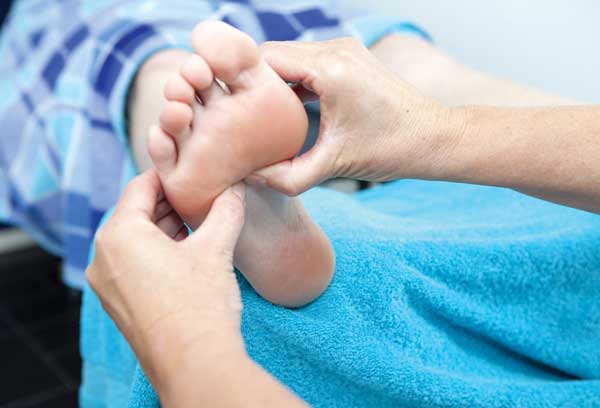 Morton’s neuroma is a painful foot condition that often occurs in response to irritation, pressure or traumatic injury to one of the digital nerves leading to the toes. A thickening of nerve tissue results as part of the body’s response to the irritation or injury. This occurs underneath the balls of the feet, most commonly between the 3rd and 4th toe joints.
Morton’s neuroma is a painful foot condition that often occurs in response to irritation, pressure or traumatic injury to one of the digital nerves leading to the toes. A thickening of nerve tissue results as part of the body’s response to the irritation or injury. This occurs underneath the balls of the feet, most commonly between the 3rd and 4th toe joints.
Anything that causes compression or irritation of the nerve can lead to the development of a neuroma. Abnormal foot movement used to compensate for bunions, hammertoes, flatfeet and other conditions can lead to irritation and development of Morton’s Neuroma. Footwear that compresses the forefoot, and/or with high heels can lead to over-load at the metatarsal heads and compression of the nerves to the toes. Excessive pronation of the foot may cause the heads of the metatarsal bones to rotate slightly, thereby pinching the nerve running between the metatarsal heads. Chronic pressure or pinching causes the nerve sheath to enlarge, becoming increasingly squeezed, producing worsening pain over time, if not addressed.
Other potential causes are activities that involve repetitive irritation to the ball of the foot, such as running or court sports. An injury or other type of trauma to the area may also lead to a neuroma.
If you have a Morton’s neuroma, you may have one or more of these symptoms where the nerve damage is occurring:
- Tingling, burning, or numbness under the forefoot or in the toes
- Pain under the forefoot
- A feeling that something is inside the ball of the foot
- A feeling that there’s something in the shoe or a sock is bunched up
In developing a treatment plan, your Podiatrist will first determine how long you’ve had the neuroma and evaluate its stage of development. Treatment approaches vary according to the severity of the problem.For mild to moderate neuromas, treatment options may include:
Padding. Padding techniques can lift and separate the metatarsal heads (balls of the feet), thereby lessening the pressure on the nerve and decreasing the compression when walking.
Icing. Placing an icepack on the affected area helps reduce swelling and pain
Orthotic devices. Custom orthotic devices provided by your Podiatrist will address any biomechanical causes for the overload and compression on the nerve, as well as providing pressure relief at the affected area.
Activity modifications. Activities that put repetitive pressure on the neuroma should be avoided until the condition improves.
Shoe modifications. Wear shoes with a wide toe box and avoid narrow-toed shoes or shoes with high heels.
Medications. Oral nonsteroidal anti-inflammatory drugs (NSAIDs), such as ibuprofen, may be recommended to reduce pain and inflammation.
Injection therapy. Treatment may include injections of cortisone, local anesthetics or other agents.
The best time to see your Podiatrist is early in the development of symptoms. Early diagnosis of a Morton’s neuroma greatly lessens the need for more invasive treatments and may avoid surgery.

